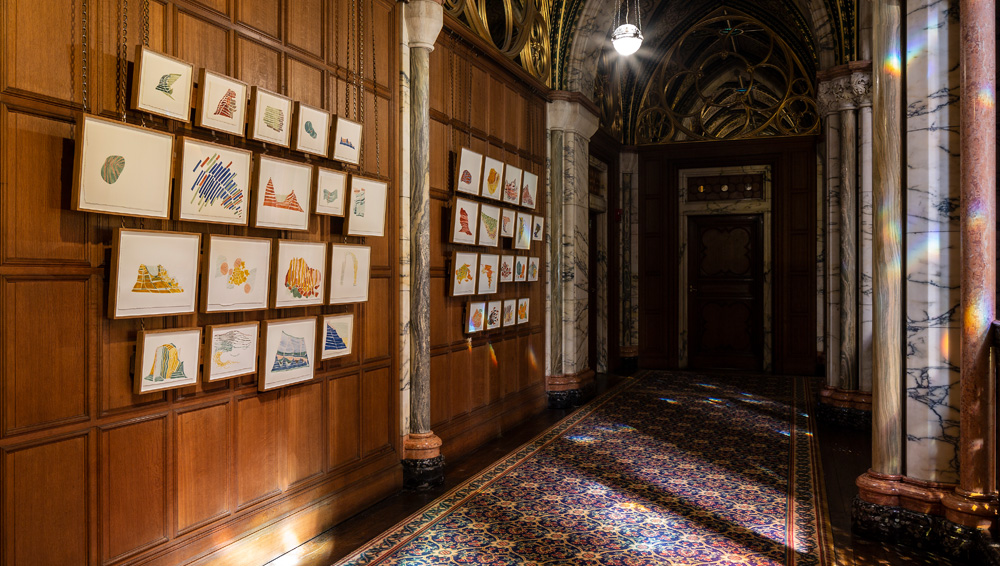
Ilana Halperin. Field Studies (from Kilchattan Bay to Hawk's Neb), 2019. Courtesy the artist and Patricia Fleming Gallery, Glasgow. Photo: Keith Hunter.
Mount Stuart Trust, Isle of Bute
6 June – 15 August 2021
by VERONICA SIMPSON
There is a volcano behind Ilana Halperin’s house, as it happens. The artist (b1973, New York) moved to Glasgow in 1998, but now divides her time between there and the picturesque Isle of Bute, where she has a house near the extinct volcano of Suidhe, to which she often walks. That modest mound is part of the fascinating geological personality of Bute that, 20 years ago, drew her to this timeless island landscape, and seems as vivid and present to her experience of daily life as the plants, trees and fields that she passes on her daily perambulations. Bute, an island just 15 miles long, straddles the Highland Boundary Fault, a geographical faultline that binds two migratory landmasses. Halperin has discovered that its unique, pegmatite-rich geological composition is very similar to that of Maine, in the US, as well Manhattan, where she grew up. Can it be coincidence? Halperin thinks not: “The reason is that at various points they were connected and ripped apart. You have these mineral cousins from across the world, not just because the same phenomena happen in different places but because at some point they were the same place.”
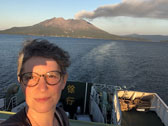
Ilana Halperin. Self portrait with Sakurajima. Photo: Ilana Halperin.
To talk with Halperin is to experience a worldview shaped by a much richer sense of time and the connections between things. The notion of personal time and planetary – geological - time are casually interwoven, as befits someone who counts leading seismologists, mineralogists, geologists and volcanologists among her friends and associates. Thanks to her painstaking process of research, facilitated by various fellowships, residencies and travels in Hawaii, Iceland, Japan, France, China, the US and the UK, she has woven a rich web of expert helpers to nourish her explorations into the connectivity of all things. Animal, mineral, vegetable - the boundaries are porous in Halperin’s practice. She talks of the evolution of a piece of woven or knitted fabric as another kind of geology: material and human narrative layered and compacted over time until the finished works express the essence of the place in which they were made and the movements and inspirations of the people who have formed their colours and geometries.
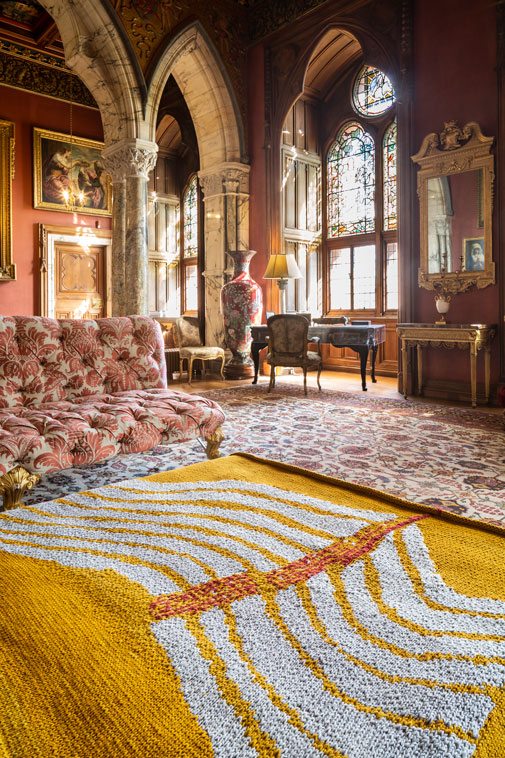
Ilana Halperin. Our Hands Enact the Geologic Process, part one, 2020. Courtesy the artist and Patricia Fleming Gallery, Glasgow. Photo: Keith Hunter.
Textiles are a new material for Halperin, and there are a few textile pieces in this show, created to respond to the extraordinary mansion at the heart of the Mount Stuart Estate, now run by the Mount Stuart Trust, as part of its annual visual arts programme – albeit delayed by a year because of the pandemic. A late 19th-century celebration of Victorian neo-gothic in deep, red sandstone, Mount Stuart is a creation channelled between the 3rd Marquess of Bute and the architect Sir Robert Rowand Anderson, to replace substantial parts of the original Georgian manor house that were destroyed by fire. Its palatial Grand Hall is filled with the finest marble; a cool, high cavern of polished columns in varied tones of cream, flecked or densely streaked with subtle greys, greens and roses, mostly sourced from Sicily, home of that most famous of Europe’s volcanoes, Mount Etna.
Halperin says: “I have never researched Sicilian marble, but it’s quite possible that the reason there is such dynamic marble is because it’s been cooked by volcanic activity.” No wonder this artist – who celebrated her 30th and 40th birthdays by visiting Eldfell, the Icelandic volcano that, like her, was born in 1973 - feels an affinity with this house. As she states in her exhibition leaflet: “The first time I visited Mount Stuart, many years ago, I was struck by the deep geologic nature of the house, from the core samples of marble which travelled up from Sicily – immigrant rocks settled in their new home – to the petrified seas found in the fossil rich limestone of the vast stairwell in the Great Hall. It was as if the house itself was an Anthropocene phenomenon, among the many geologic wonders one could encounter on the island.”
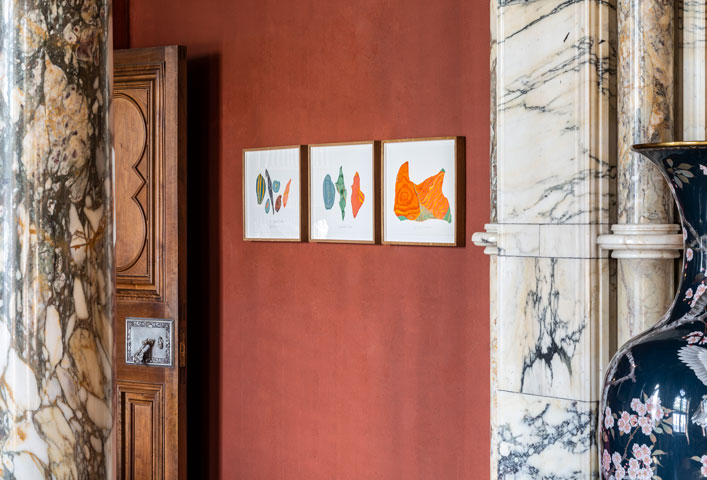
Ilana Halperin. My Conglomerate Family I, II, III, 2019. Courtesy the artist and Patricia Fleming Gallery, Glasgow. Photo: Keith Hunter.
The first of her works for this exhibition – three watercolours and one textile - are shown in the opulent comfort of Mount Stuart’s Drawing Room, the first piece created during the last year, for Crystal Clear, an exhibition at the Pera Museum in Istanbul, to which Halperin was invited to contribute. Wanting to minimise her carbon footprint, she had one of her Bute watercolours translated into knitted form by Knitstanbul, a social enterprise of Syrian refugee women. And here it is (Our Hands Enact the Geologic Process, part two, 2020), creamy, contoured bands of wool travelling, like the striations of a geological cross-section, over a golden ground, with terracotta detail; the piece is draped – where it looks entirely at home – over a plump, antique footstool, upholstered in red velvet and fringed with gold tassels. The three watercolours, My Conglomerate Family, I, II and III (2019), are grouped by the door into the library. Inspired by specific stones, they are rendered more as expressions of emotional feeling and tone, rather than in exact scientific detail, as a group, a trio and a singular piece, the latter beautifully evoking the deep, orangey glow of agate.
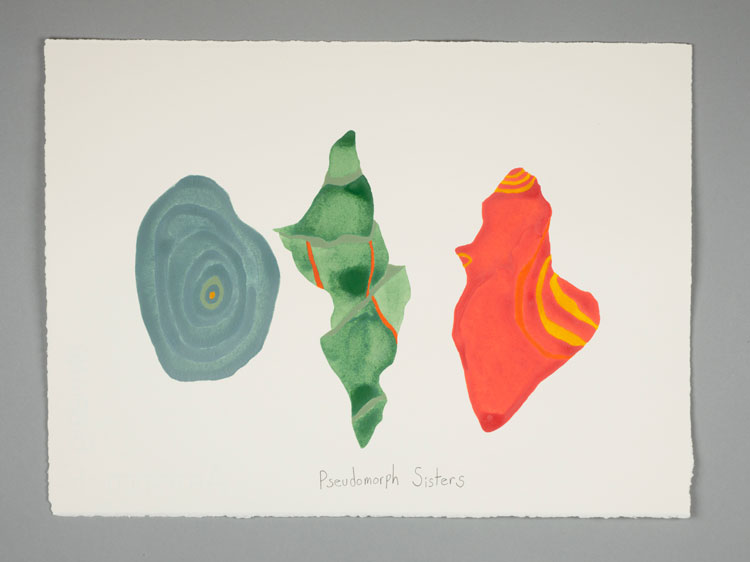
Ilana Halperin. Pseudomorph Sisters, 2019. Photo: Alan Dimmick. Courtesy of the artist and Patricia Fleming, Glasgow
For Halperin, these are portraits representing her natural and “chosen” family. “When I made these works – before the pandemic – I had been imagining and trying to conjure more expansive ways of thinking about my own family, from very deep-time family lines drawn in the calcium carbonate of our teeth and bones, to more immediate alternative families based not only on blood, but on how we choose each other, how we love each other … Conglomerates held together by feeling.” In tone and spirit, these works complement the room’s botanical print fabrics and drapes, the marble fireplace, gold-framed portraits, terracotta walls and the agate-topped tables.
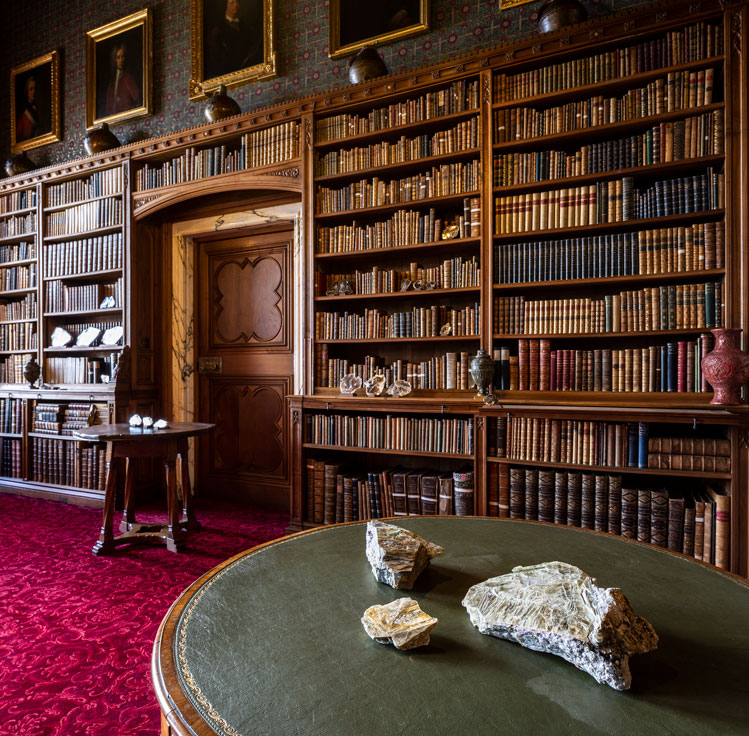
Ilana Halperin. The Library, 2020. Courtesy the artist and Patricia Fleming Gallery, Glasgow. Photo: Keith Hunter.
However, it is the ceiling of this room that triggered the works in the adjacent library: not the coats of arms festooned across its surface, revealing the alliances made by the aristocratic family that has owned and managed the estate for nearly 1,000 years, but the background against which they are placed: it looks like mirror but is in fact mica – a material prevalent in the pegmatite belts of Scotland and North America. This, for Halperin, was the starting point of her dialogue around the exhibition when she visited to discuss the commission in 2018.
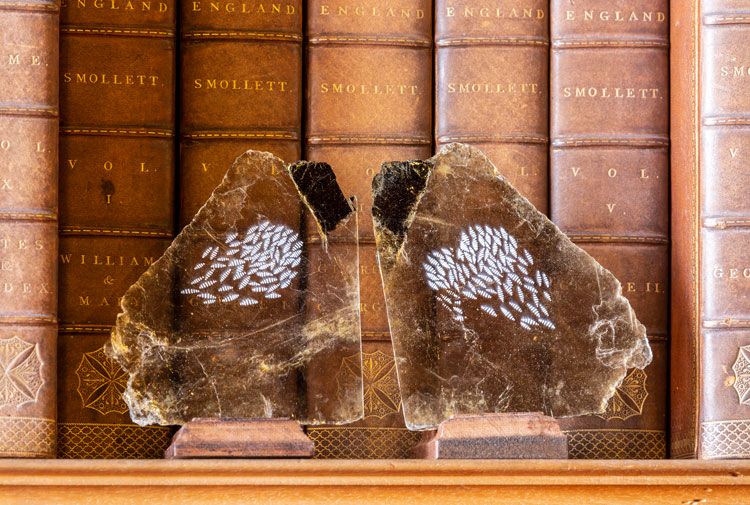
Ilana Halperin. The Library (detail), 2020. Courtesy the artist and Patricia Fleming Gallery, Glasgow. Photo: Keith Hunter.
“I’ve been wanting for many, many years to see if it’s possible to work with larger volumes of mica,” says Halperin, whose interest in geology may well stem from a childhood enchanted by the glittering specks of mica visible on the pavements of Manhattan and peeling shiny leaves, or “pages” of it from boulders she found on the beach. Larger, richly layered samples are termed “books”, so the library was a perfect location. Having sourced – through her networks – some sizeable chunks from Maine as well as smaller, Scottish samples from Inverness, Halperin has laser-etched patterns on to their surfaces, inspired by the “trace fossils” she was working with in 2015, when Studio International last interviewed her; where a fossil represents the death of some life form, captured for posterity, trace fossils record movement - footsteps or the impressions left by animals as they pass through a space. Halperin sees drawing – especially etching – as an echo of that process. She collaborated with Dundee Contemporary Arts’ impressive print studio to create these new works. “The drawings are melted and crystallised into the mineral itself, so they look like scratches, but actually they become a kind of mineral layer of history. The making of a drawing is a trace fossil, but this is a collaboration between technology, human and mineral that is an act of creating a trace fossil.” They bridge a colossal gap in time – the drawings of 2020 on these mica chunks that date back between 400m and 800m years.
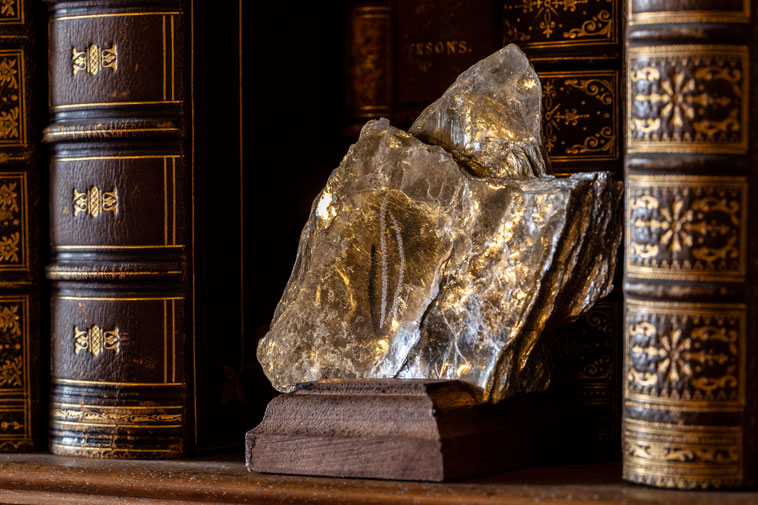
Ilana Halperin. The Library (detail), 2020. Courtesy the artist and Patricia Fleming Gallery, Glasgow. Photo: Keith Hunter.
Placed all around the room, they are utterly mesmerising. Not only is there the glimmer of silver to pleasure the eye, but there is the enchantment of coming up close and discovering Halperin’s delicate crystalline, laser-etched trails and prints embedded in their surface. Mounted on their bespoke, wooden plinths, and arranged against shelves of priceless, leather-bound tomes, they also look utterly at home. Halperin agrees: “It’s such a complex material, it’s so layered: the more you look the more you discover.” She points out the different qualities of the Scottish and Maine samples: “There’s muscovite mica, these golden silvery ones, with elements of tourmaline, which are from Maine - the first place in America they discovered tourmaline.” The Scottish pieces are darker, smaller, almost translucent, the etchings standing out against the base stone of black Iotite.
In a display case at the centre of the room, Halperin has gathered some of her research into Mount Stuart’s archives: diaries, notebooks and correspondences, watercolours and souvenirs from the travels of John Stuart, 3rd Earl of Bute, in Rome and Naples between 1769 and 1771. These traces of movement and exploration, which attest to the family’s long relationship with volcanoes, are paired with contemporary records of Halperin’s own geological explorations, including photos, diaries and a piece of lava collected on her behalf from the Fagradalsfjall eruption in Iceland in March this year.
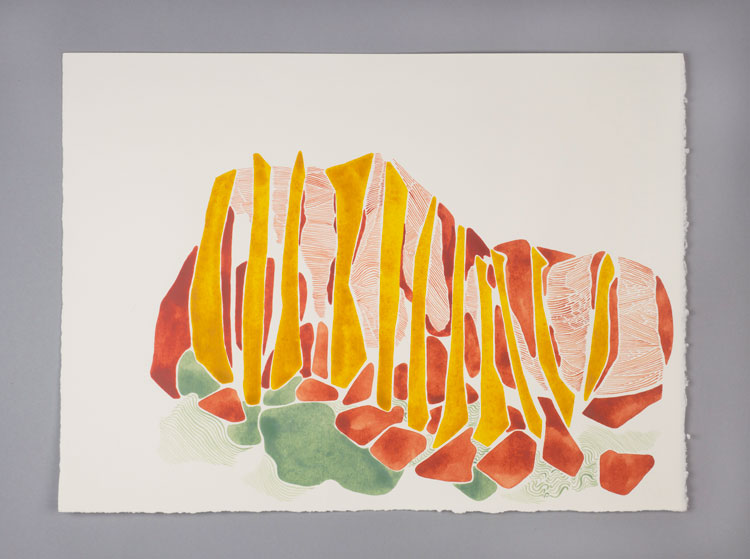
Ilana Halperin. Field Studies (from Kilchattan Bay to Hawk’s Neb) 1-36 Watercolour on Fabriano paper, 2019. Courtesy of the artist and Patricia Fleming, Glasgow. Photo: Alan Dimmick
From here, we move to the gallery, where Halperin’s watercolours are scattered across one wall, in all their geological richness and variety, bearing witness to the processes of formation, erosion and growth she has observed on the island through the years and different seasons. Apparently, she doesn’t draw these from life, but rather takes her observations home with her to paint from memory – and it strikes me that the particularities of that memory are also like a trace fossil in her mind. Halperin agrees: “I am often recording specific details or phenomena or a colour I’ve never encountered before. I have observed these landscapes through multiple seasons and multiple years … it’s a very layered relationship to each place.”
It seems an entirely natural evolution to move from these tones and forms in the watercolours to the two sumptuous textile pieces awaiting us in the adjacent bedrooms. These were woven by Bute’s own weavers, Bute Fabrics, on jacquard looms, and are titled as a pair: Our Hands Enact the Geologic Process, part one (2020). Creating textiles, says Halperin, “is something I have wanted to do for a long time. So, I have my long incubation period for ideas … and it wasn’t until the right moment came, and the right moment was with Bute Fabrics, which I had visited many times – as a resident, I’d skulk in the sales and snap up offcuts. In this way, I have been living with Bute Fabrics in my home for ages and have always appreciated the unbelievably rich quality of textile they produce, because my mother trained me well and I grew up surrounded by textiles.” Her mother, it turns out, was a noted fashion designer, creator of textile designs and clothes through the 60s and 70s, before turning to high-end hand-knitted clothing in the 80s. To add an extra layer of poignancy, Halperin lost her mother during the last year, to dementia, so there is more than a touch of her mother’s legacy in these pieces. I am particularly drawn to the gorgeous red weave that covers the bed in the Horoscope bedroom, its granular background cream-flecked, like marble, and bearing long, elegant lines of gold.
The final pieces are found downstairs, in the crypt. Here, Halperin revisits a technique of real-time calcification, a process she discovered in 2008 when she began her relationship with the small thermal town in Auvergne where seven generations of the Papon family have run the Fontaines Pétrifiantes de Saint Nectaire to create “cave casts” by placing objects on 25-metre high “casting ladders” directly beneath carbonate waterfalls inside a volcanic mountain. Objects placed on this ladder take only a year to acquire a centimetre layer of calcium carbonate (limestone), where the normal process would take 100 years.
For this show, Halperin shipped over to the Fontaines some old bricks, pipes and tiles that she has been gathering since 2016 from the beaches around Bute, remnants of the brick and lime kilns that used to operate in Kilchattan Bay. “It seemed a good moment to look at that process I’d worked with before, but revisit it with a new lens, thinking about it in relation to the house and the island and the geological processes you can encounter here. Again, (it’s about) having a very personal awareness in relationship to the materials I’m surrounded by. Often when I work, I’ll have a very long incubation period. I’ll be drawn to certain materials and let myself not really understand why I’m drawn to something or what I’m going to use something for until an idea really starts to distil for a longer period of time.”
In this case, she says, the work resonated with the anxieties of the prevailing pandemic and the hysteria emanating from Brexit and Donald Trump’s rhetoric against migration. “I liked the idea of creating hybrid rocks made from material from two distinct locations to re-enact the process of how land mass originally formed and how places that we understand as separate originally formed. We think of Bute as one island, one place, but it’s formed from two sides of the Highland Boundary Fault that crashed together. But before they formed Bute, these land masses lived all over the world and they travelled everywhere and they were migratory … It’s about making healthy, geo-cultural rocks as a kind of contemplation point.

Ilana Halperin. The Rock Cycle, 2021. Courtesy the artist and Patricia Fleming Gallery, Glasgow. Photo: Keith Hunter.
“All these systems are interconnected, which is something I also love. So for the rock cycle work, they’re made of limestone. And limestone is uncooked marble. And also limestone is originally made or formed from calcium carbonate life. And so this idea that cyclical processes, life cycles, geological cycles, Earth cycles, ways that they all mirror each other and are all embedded as continuous cycle … all blends into my thinking.” And the manifestations of this thinking, in this extraordinary house, make one leave this exhibition all the richer for that journey Halperin has taken us on through time and matter.